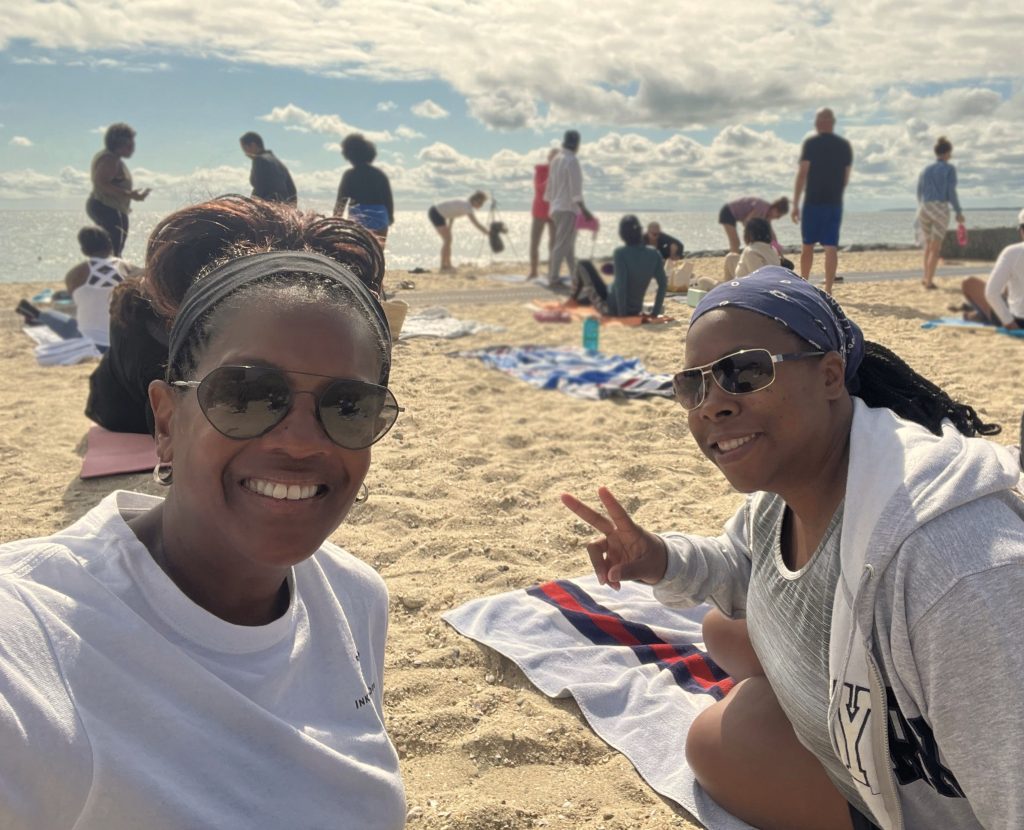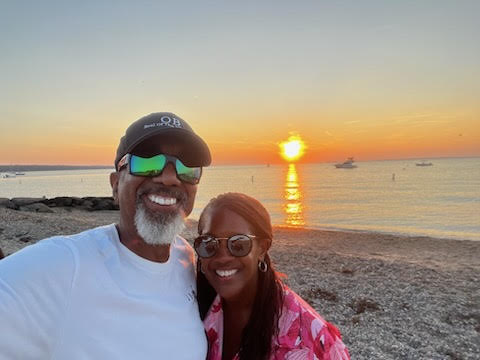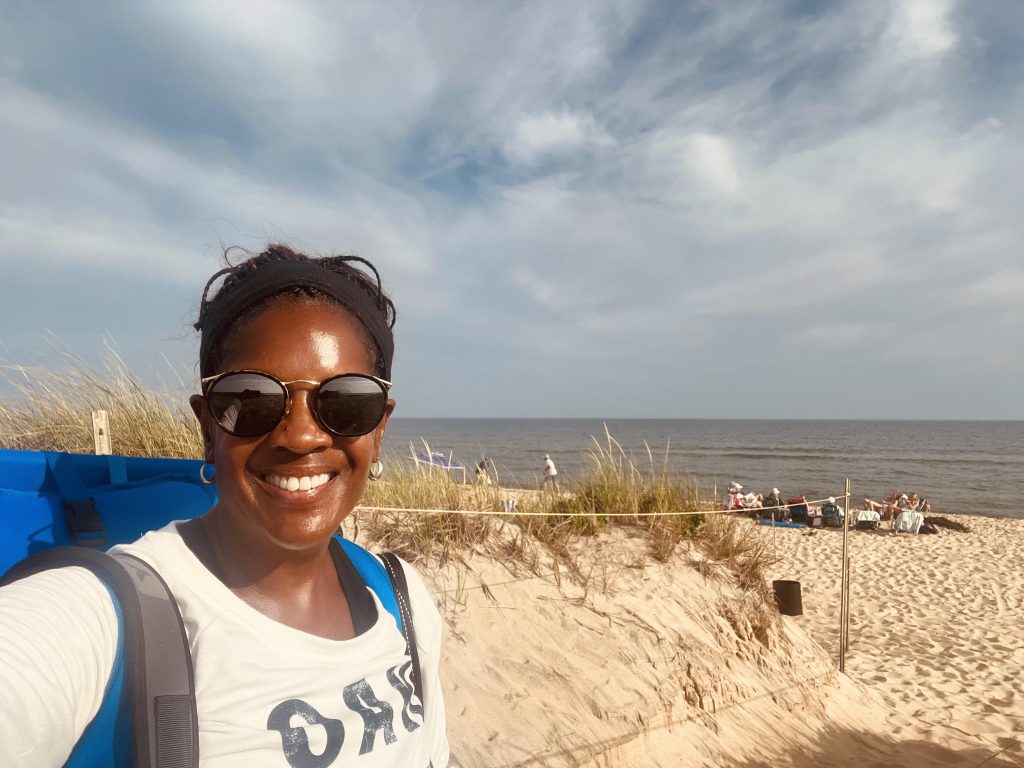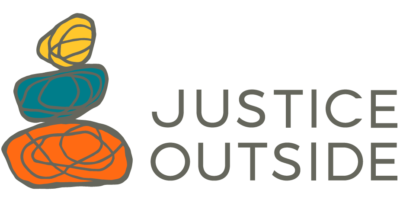By Kim Moore Bailey, Justice Outside President & Chief Executive Officer
I just recently returned to work after a three-month sabbatical made possible by Justice Outside’s policy to ensure paid rest for staff after five years of consecutive work at the organization. It took me ten years to take the time off. Two years ago, if someone had told me I’d be able to take three months off from the work that I deeply care about and rest fully, I wouldn’t have believed them. With deadlines, fundraising responsibilities, expanding staff and programs, and a strategic plan I’d committed to, it felt impossible. In order to really embrace my sabbatical, I had to shift my thinking and I’m so grateful I did.
Rest is not easy.
Getting into the rest mindset was a challenge at first. One of the many books on my summer sabbatical reading list was Rest is Resistance: A Manifesto by Tricia Hersey. There is a lot to unpack in her book and my references here only begin to scratch the surface. Hersey states, “The idea of rest as resistance and rest as reparations can be challenging to distill in a few lines. It is counterintuitive to believe rest to be not a place to waste time but instead a generative place of freedom and resistance. We have never learned this in our culture. The thought of not doing, even for a short time, is seen as lazy and unproductive. So, an explanation for rest as a form of justice is layered and nuanced.” It took a while to accept and settle into the idea that my job for the next few months was to rest. During the first two weeks, I kept checking my email, not because I was worried about work or Justice Outside, but because I was worried about myself. What would I do without work? It is one thing to turn off your email and stop looking at your phone (which I eventually did). It is another thing to turn off your brain. To give yourself permission to not think about work was work. It took about three weeks before what a friend and colleague coined as “sand gravity” kicked in. She said, “you will make your way to the beach and before you know it, hours will have passed, maybe you even took a nap. Your body and your mind will shift and settle, and you won’t want to move.” When it did happen, I think I actually cried.

Twice during my three-month break, I panicked as I found myself wondering, am I doing this right? Should I be doing more during this sabbatical? Every time someone asks me, “what are you doing during your sabbatical?” I heard judgment and accusations that I was wasting time and being unproductive. The idea that even rest had to be done “right” crept in and the idea of doing it wrong and letting my team and myself down overwhelmed me. Serendipitously, each time this thought showed up, I had the chance to speak with someone who had also taken a sabbatical. The generosity with which they shared their experiences, what they wished they had done more of (rest) and their validation of my decision to take a sabbatical and turn off my work-brain was such a gift. Hersey writes: “Rest makes us more human. It brings us back to our human-ness.” They understood this and helped me see it too.
Towards the middle of my sabbatical, I routinely forgot my phone at home when I left for outings. That was liberating and it gave me the chance to connect more deeply with nature and with the people around me. I began to truly understand what it meant to sit still in a way that was deeper than previous attempts.
“To be more human. To be connected to who and what we truly are is at the heart of our rest movement,” Hersey writes. The more I leaned into the idea of rest as my mission, the more connected I felt. Each beach day offered small moments of joy and deepened my curiosity as I noticed how busy the sand crabs were or watched a grandmother patiently encourage her grandchild into the water promising over and over “I got you, I got you.” Watching the sunset was an event, witnessing the sky turn vibrant colors and joining the round of applause that often followed when the last glimpse of the sun disappeared below the horizon.
I also saw the stars with new eyes. I usually don’t even notice the stars but the stars there were so brilliant. An explosion of stars made me dizzy as I looked into an app to align and identify stars. They are always there, it made me wonder how did I miss this, how did I stop seeing this. The experience gave me goosebumps and filled me with gratitude. Is this really my life now? How lucky am I to lose myself so deeply in a sea of glittering stars. I was connected in ways that were so much bigger than me and it felt intimate and personal at the same time.
There’s been a lot of news coverage of the healing power of nature in recent years. I’ve always known about that because of my heritage. Black and Indigenous people have been deeply connected to the stars, the lands, and the waters around us. It was healing to stand still and reconnect with that part of myself.
Location matters.

I chose to spend the majority of my sabbatical on Martha’s Vineyard for several reasons. I’ve been there before so it felt familiar, and this allowed me to explore at a pace that allowed a slow unfolding of things that were new to me and a comfort in revisiting places I had been before. I was also intentional about wanting to be in one place, to truly unpack, and be present, to witness the produce shift with the season at the farmer’s market, to buy a candle, light it, and burn it slowly, not pack it up and bring it home.
Despite being familiar, the Vineyard always has surprises. I found myself on new beaches, at new restaurants, and getting to know the culture and community in a deeper way. Because I was there for a longer period of time than my annual, two-week visits, I got to see the abundance of wildflowers that filled a corner lot that otherwise appeared to just be a grassy space.
I also picked Martha’s Vineyard because of the Black community that is present there. I didn’t want to go somewhere where I’d be the only one. The sense of community and belonging was essential for me to feel truly rested. And it showed up in so many different ways. I was excited to not only support businesses owned by Black people but to support the people running the business. To engage with them beyond a transaction to hear their story and be in community with them.
This connectedness introduced me to a fuller picture of this place I have come to love. I learned more about the island’s Black history from someone who grew up there. She showed me what redlining looked like, and shared her own journey and the challenges with securing year around housing for herself and her family as we drove past large seasonal homes that were empty. I showed up for the Polar Bears, a group of Black swimmers gathering on the island since 1946, not just for the morning exercise but because of the community of mostly women who were there, carrying forward a tradition from 77 years ago. I became a member and paid my dues. I was still a visitor, and I felt the shift from no longer being a tourist. What I did and could do mattered. I found myself moving with more intentionality, contributing more thoughtfully, getting a library card, dropping items off at the food bank, riding my bike, tipping generously, sharing the narratives that I had learned. It all mattered in ways that gave new meaning to me.
Click here to learn more about Martha’s Vineyard’s Black history.
Rest is a teacher.

In Rest is Resistance, Hersey spends time identifying all the ways in which we have been programmed to believe in the grind culture and that our value and worth are tied to our productivity. At one point, she looks at school and academia as an early source of this messaging. She states, “The stress, anxiety, overloaded curriculum, and pressure we normalize in public schools and higher education are toxic and dangerous for everyone involved, but particularly toxic for young children and young adults who are still developing a sense of self. They are exposed to the lie that their worth is determined by how much they can accomplish constantly, and it’s reaffirmed and rewarded when they push their bodies to the limit to do well in classes. Many also begin to pour themselves into the life of perfectionism which is a function of white supremacy. We internalize the toxic message received from the culture and begin to hate ourselves unless we are accomplishing a task. We seek external validation from a violent system void of love.”
During my sabbatical, rest was my teacher. It showed up with love and allowed me to see myself caught up in this toxic message. Hersey says, “Dreaming and creating the space to dream is the remedy and the cure.” What I know is that it is hard to dream if you cannot rest. As I return to work, I am holding on to so much of what I learned and felt these past 3 months. I want to bring forward the gift of spending time with people in meaningful, thoughtful ways; I want to spend more time looking up at the stars and less time looking down at my phone. I must fight for the time to rest, and it starts with pushing back on days filled with back-to-back meetings without any breaks. No one benefits from a schedule like that so why keep doing it?
To build a better, more equitable, more sustainable, more joyful world for our people, we need to be well-rested and able to dream about what this looks and feels like. This sabbatical was a step towards learning and practicing that for myself and I’m deeply grateful for it.

